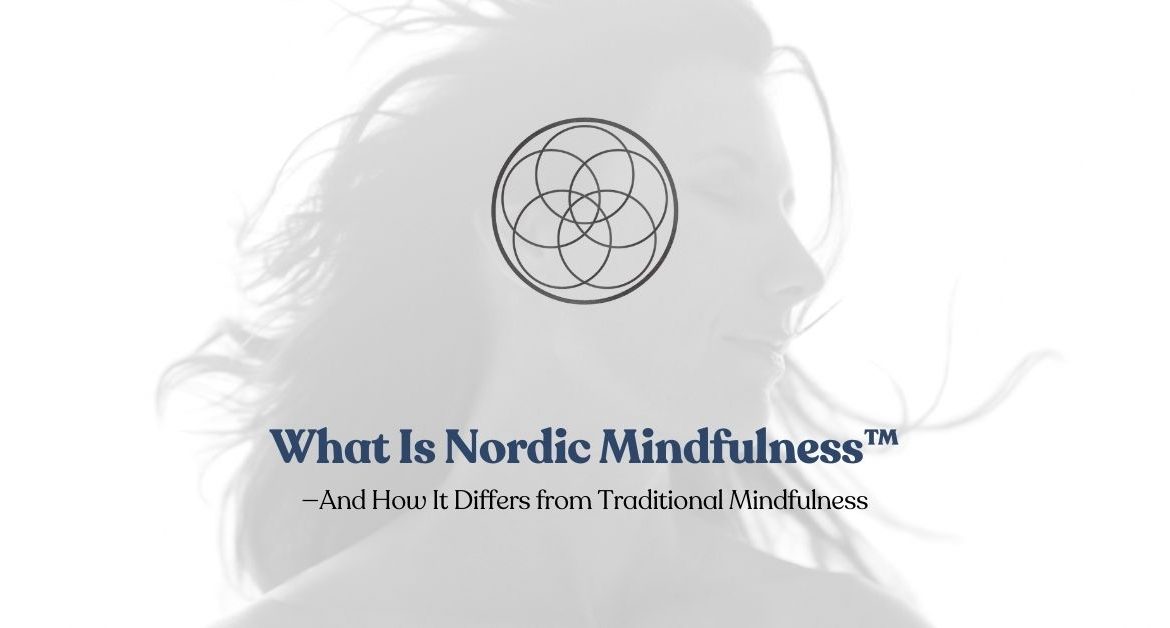

What Is Nordic Mindfulness™—And How It Differs from Traditional Eastern Mindfulness
Mindfulness has become a global practice known for its power to reduce stress, deepen awareness, and anchor us in the present. But not all mindfulness is the same. While most are familiar with mindfulness through Eastern traditions—often rooted in Buddhism or yoga—there’s another approach quietly emerging from the North: Nordic Mindfulness™.
This isn’t just a variation. It’s a distinctive way of being—shaped by forests, seasons, music, and stillness. It doesn’t replace traditional mindfulness—it reimagines it. Let’s explore how.
Traditional Mindfulness: The Foundation of Observation

At the heart of Eastern mindfulness is observation. You watch your thoughts, notice your breath, return to the moment when the mind wanders. Stillness is often the goal, silence is sacred, and the ultimate aim is equanimity—peace amidst chaos.
You learn to step back from the noise to find space between reaction and response. It’s powerful. It’s timeless. And it’s often practised through sitting meditation, breath awareness, and non-attachment.
Nordic Mindfulness™: The Art of Immersive Presence
Now imagine a different setting: the hush of a snowy forest, the warmth of a fire after a long walk, music made from the energy of trees, and the scent of moss on the wind.
Nordic Mindfulness™ invites you not to watch from the shore—but to step into the ocean.
To feel it, taste it, move with it. To listen not just with your ears but with your whole being.
It’s about relational presence—where nature is not a backdrop, but a partner. Stillness is not a goal to reach, but a rhythm that finds you when you’re deeply connected. The silence between the sounds speaks as much as the sound itself.
Key Differences of Traditional Versus Nordic Mindfulness™
| Aspect | Traditional Mindfulness | Nordic Mindfulness™ |
|---|---|---|
| Core Focus | Observation, detachment, inner stillness | Immersion, connection, inner wisdom |
| Nature’s Role | Symbolic or background | Central, relational, full of presence |
| Stillness | Goal of practice | Natural state that arises through immersion |
| Sound vs Silence | Emphasis on silence | Embraces sound and silence (nature, music, breath) |
| Structure | Structured practice (e.g. meditation, breathwork) | Rhythmic, seasonal, intuitive, embodied |
| Creative Expression | Not typically integrated | Encouraged as a pathway to presence |
| Way of Being | Practice-oriented | Lived, felt, cyclical experience |
| Spiritual Intention | Inner peace, detachment from ego | Embodied wisdom, integration, connection |
Commonalities:
“The heart of both paths is presence, but the journey there differs.”
While Nordic Mindfulness™ and traditional Eastern mindfulness may differ in approach, style, and cultural flavour, they are not at odds. In fact, beneath their surface differences lies a shared purpose—one that transcends geography and lineage.
Both traditions are ultimately about coming home to ourselves and they both invite us to:
- Be present—to truly arrive in the here and now without needing to change, fix, or rush through it.
- Cultivate compassion—for ourselves, for others, and for the inevitable messiness of being human.
- Observe without judgment—learning to witness our thoughts, emotions, and experiences without labelling them as good or bad.
- Let go of control—releasing the need to manage every detail and softening into trust and openness.
- Listen deeply—whether that means turning inward to hear the quiet voice within, or outward to the subtle wisdom of the world around us.
Ultimately, they’re not opposites—they’re complementary languages for remembering how to be alive, aware, and well. However, where Eastern mindfulness often uses stillness, detachment, and disciplined observation as a way in, Nordic Mindfulness™ walks a more immersive path—through forest, firelight, rhythm, story, silence, and song.
The B.R.A.I.S.S.™ Principles: The Framework of Nordic Mindfulness™
What makes Nordic Mindfulness™ uniquely structured is the B.R.A.I.S.S.™ framework—a set of guiding principles that offer both depth and direction:
- Balance – Honouring rhythm, not rigidity.
- Resilience – Rooting in inner strength and seasonal adaptation.
- Adaptability – Shifting with life rather than resisting it.
- Integration – Embodying the lessons, not just observing them.
- Simplicity – Choosing what matters and letting go of excess.
- Synergy – Living in harmony with self, others, and the world.
These principles turn Nordic Mindfulness™ into a whole-being experience, not just a momentary practice. They bring shape to the immersion and help guide transformation gently and sustainably.
Final Thoughts:
“If traditional mindfulness teaches us how to watch the river, Nordic Mindfulness™ invites us to step into it—to feel its current, listen to its song, and learn from its flow”.
Nordic Mindfulness™ isn’t something you “do” once a day. It’s a way of being. You practise it while walking through the woods while sipping tea slowly while listening to a tree’s frequency turned into music, or even while pausing between thoughts and asking, What is this moment trying to tell me? Stillness is welcome here—but so is sound, story, rhythm, and breath.
Instead of retreating from life, Nordic Mindfulness™ nudges you to immerse into it—fully, gently, and with presence.
And the goal?
Not perfection. Not performance. Not some polished idea of peace. But rather—to live immersed in presence. To meet life as it is, in rhythm with nature, in connection with your inner knowing. To remember. To feel. To return.
It may sound simple. But this kind of immersion is a radical, powerful act in the world we live in.
Learn more about Nordic Mindfulness™ and the BRAISS™ Principles at nordicmindfulness.com



